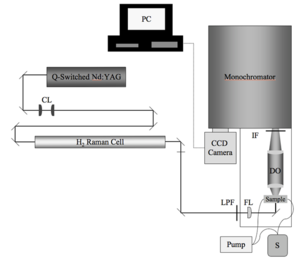Hyper Rayleigh Scattering
Hyper Rayleigh Scattering (aka Harmonic Light Scattering) is one method for measuring β.
Overview
An incident laser generates a second harmonic signal, specifically the frequency double signal. This can be related to the beta of the sample using this formula:
- <math>\frac {I_{sample}} {I_{solvent}} = \frac {N_{sample} \langle \beta^2 _{sample} \rangle + N_{solvent} \langle \beta^2_{solvent}\rangle} {N_{solvent} \langle \beta^2_{solvent}\rangle}\,\!</math>
See Firestone 2004 [1].
See Wikipedia on Rayleigh Scattering
See also Density Functional Theory
Technique
Video to come
Significance
References
- ↑ K. A. Firestone, P. Reid, R. Lawson, S. H. Jang, and L. R. Dalton, “Advances in Organic Electro-Optic Materials and Processing,” Inorg. Chem. Acta, 357, 3957-66 (2004)

